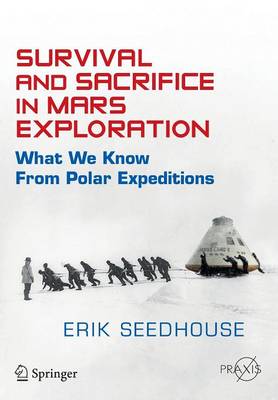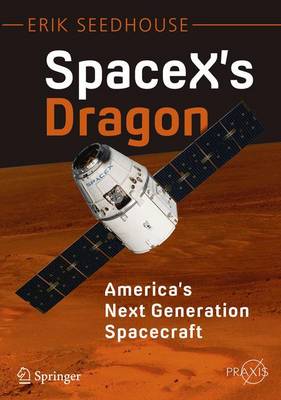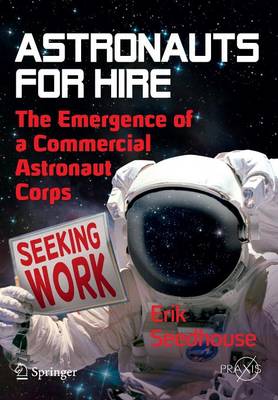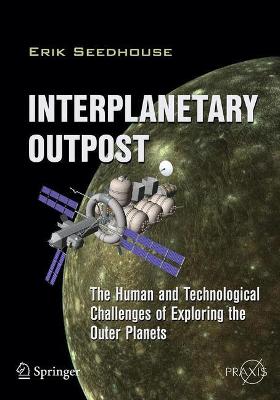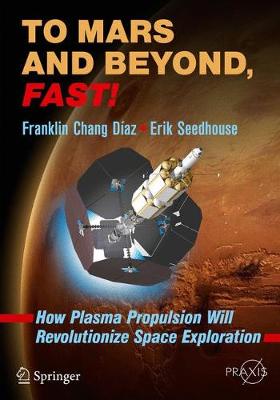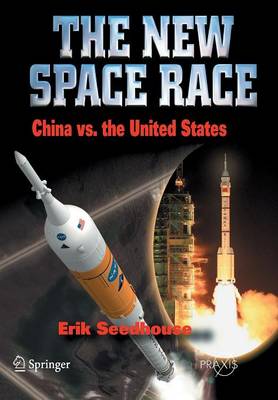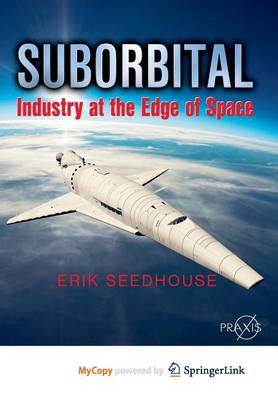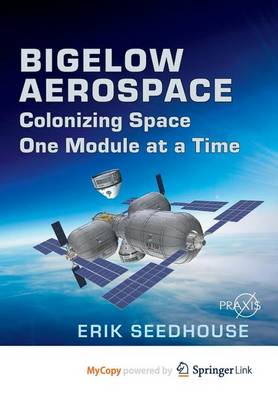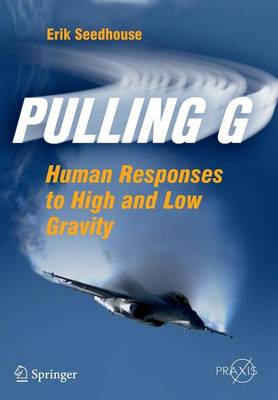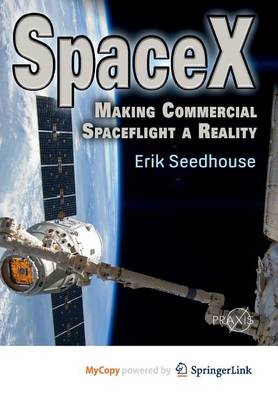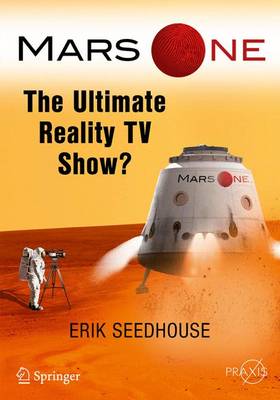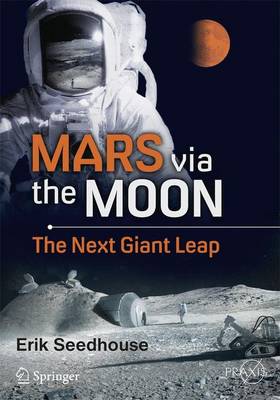Springer Praxis Books
16 total works
With current technology, a voyage to Mars and back will take three
years. That’s a lot of time for things to go wrong. But sooner or later
a commercial enterprise will commit itself to sending humans to Mars.
How will the astronauts survive? Some things to consider are:
ith current technology, a voyage to Mars and back will take threeyears. That’s a lot of time for things to go wrong. But sooner or later
a commercial enterprise will commit itself to sending humans to Mars.
How will the astronauts survive? Some things to consider are:
• Who decides what medical resources are used for whom?
Who decides what medical resources are used for whom?• What is the relative weight of mission success and the health of the
crew?
What is the relative weight of mission success and the health of thecrew?
• Do we allow crewmembers to sacrifi ce their lives for the good of themission?
Do we allow crewmembers to sacrifi ce their lives for the good of themission?
• And what if a crewmember does perish? Do we store the body for
return to Earth or give the member a burial in space?
Questions like these, and hundreds of others, have been explored by
science fi ction, but scant attention has been paid by those designing
missions. Fortunately, the experience gained in polar exploration more
than 100 years ago provides crews and mission planners with a framework
to deal with contingencies and it is this that forms the core of this book.
Why the parallels between polar and space exploration? Because polar
exploration offers a better analogy for a Mars mission today than those
invoked by the space community. Although astronauts are routinely
compared to Lewis and Clark, Mars-bound astronauts will be closer in their
roles to polar explorers. And, as much as space has been described as a
New Frontier, Mars bears greater similarity to the polar regions, which is
why so much can be learned from those who ventured there.
And what if a crewmember does perish? Do we store the body forreturn to Earth or givethe member a burial in space?Questions like these, and hundreds of others, have been explored by
science fi ction, but scant attention has been paid by those designing
missions. Fortunately, the experience gained in polar exploration more
than 100 years ago provides crews and mission planners with a framework
to deal with contingencies and it is this that forms the core of this book.
Why the parallels between polar and space exploration? Because polar
exploration offers a better analogy for a Mars mission today than those
invoked by the space community. Although astronauts are routinely
compared to Lewis and Clark, Mars-bound astronauts will be closer in their
roles to polar explorers. And, as much as space has been described as a
New Frontier, Mars bears greater similarity to the polar regions, which is
why so much can be learned from those who ventured there.
Dragon V2 is a futuristic vehicle that not only provides a means for NASA to transport its astronauts to the orbiting outpost but also advances SpaceX’s core objective of reusability. A direct descendant of Dragon, Dragon V2 can be retrieved, refurbished and re-launched. It is a spacecraft with the potential to completely revolutionize the economics of an industry where equipment costing hundreds of millions of dollars is routinely discarded after a single use. It was presented by SpaceX CEO Elon Musk in May 2014 as the spaceship that will carry NASA astronauts to the International Space Station as soon as 2016.
SpaceX’s Dragon – America’s Next Generation Spacecraft describes the extraordinary feats of engineering and human achievement that have placed this revolutionary spacecraft at the forefront of the launch industry and positioned it as the precursor for ultimately transporting humans to Mars. It describes the design and development of Dragon, provides mission highlights of the first six Commercial Resupply Missions, and explains how Musk hopes to eventually colonize Mars.
Lunar Outpost provides a detailed account of the various technologies, mission architectures, medical requirements and training needed to return humans to the Moon within the next decade. It focuses on the means by which a lunar outpost will be constructed and also addresses major topics such as the cost of the enterprise and the roles played by private companies and individual countries. The return of humans to the surface of the Moon will be critical to the exploration of the solar system. The various missions are not only in pursuit of scientific knowledge, but also looking to extend human civilization, economic expansion, and public engagement beyond Earth. As well as NASA, China's Project 921, Japan's Aerospace Exploration Agency, Russia, and the European Space Agency are all planning manned missions to the Moon and, eventually, to Mars. The Ares-I and Ares-V are the biggest rockets since the Saturn V and there is much state-of-the-art technology incorporated into the design of Orion, the spacecraft that will carry a crew of four astronauts to the Moon. Lunar Outpost also describes the human factors, communications, exploration activities, and life support constraints of the missions.
Section I begins by describing how Astronauts for Hire (A4H) was created in 2010 by Brian Shiro, a highly qualified NASA astronaut candidate, and a group of other astronaut candidates. Erik introduces A4H's vision for opening the space frontier to commercial astronauts and describes the tantalizing science opportunities offered when suborbital and orbital trips become routine.
Section II describes the vehicles astronauts will use. Anticipation is on the rise for the new crop of commercial suborbital and orbital spaceships that will serve the scientific and educational market. These reusable rocket-propelled vehicles are expected to offer quick, routine, and affordable access to the edge of space, along with the capability to carry research and educational crew members. The quick turnaround of these vehicles is central to realizing the profit-making potential of repeated sojourns by astronauts to suborbital and orbital heights.
Section III describes the various types of missions this new corps of astronauts will fly and who will hire them. For example, suborbital flights may be used to do high altitude astronomy, life science experiments, and microgravity physics. This section continues with an examination of the types of missions that will accelerate human expansion outward, to Exploration Class missions through lunar bases, the establishment of interplanetary spaceports, and outposts on the surface of Mars. Along the way it describes the tasks commercial astronauts will perform, ranging from mining asteroids to harvesting helium.
This book serves as a go-to reference guide for suborbital scientists and those seeking to learn how one company has found success. Additionally, it describes the medical and training requirements for those flying on board the Lynx and the related critical roles of the astronaut trainers and a new breed of commercial space pilots. The end result is a thorough chronicle of the development of rocket propulsion, avionics, simulator and ground support operations being put into play by XCOR with the Lynx.
The world’s most populous nation views space as an asset, not only from a technological and commercial perspective but also from a political one. The repercussions of this ideology already extend far beyond Washington. China vs. the United States explores future Chinese aspirations in space and the implications of a looming space race.
Dr. Seedhouse provides background information on the fifteen-year history of the China National Space Administration and its long list of accomplishments. Sino-U.S. technological and commercial interests in space are discussed, including their interest in encouraging a potential space race. The national security objectives of the U.S. and China are also examined.
For centuries the British developed a reputation as a nation of explorers. From Francis Drake’s circumnavigation of the globe to the ascent of Everest, British explorers crossed oceans and continents and ventured where few, if any, had gone before. Until very recently, that legacy of exploration had not extended to space. For decades, successive governments chose to stay out of the human spaceflight programme, but in 2008 there were signs of optimism when ESA selected a new class of six astronauts, including, for the first time, a British representative: Timothy Peake.
This book puts the reader in the flight suit of Britain’s first male astronaut. In addition to delving into the life of Tim Peake, this book discusses the learning curves required in astronaut and mission training and the complexity of the technologies required to launch an astronaut and keep them alive for months on end. This book underscores the fact that technology and training, unlike space, do not exist in a vacuum; complex technical systems, like the ISS, interact with the variables of human personality, and the cultural background of the astronauts. But ultimately, this is the story of Tim Peake and the Principia mission and the down-to-the-last-bolt descriptions of life aboard the ISS, by way of the hurdles placed by the British government and the rigors of training at Russia’s Star City military base.
The nascent commercial suborbital spaceflight industry will soon open the space frontier to commercial astronauts, payload specialists, scientists and of course, tourists. This book describes the tantalizing science opportunities to be offered when suborbital trips become routine within the next 12 to 18 months. It describes the difference in training and qualification necessary to become either a spaceflight participant or a fully-fledged commercial suborbital astronaut and it describes the vehicles this new class of astronauts will use.
Anticipation is on the rise for the new crop of commercial suborbital spaceships that will serve the scientific and educational market. These reusable rocket-propelled vehicles are expected to offer quick, routine and affordable access to the edge of space along with the capability to carry research and educational crew members. Yet to be demonstrated is the hoped-for flight rates of suborbital vehicles.
Quick turnaround of these craft is central to realizing the profit-making potential of repeated sojourns to suborbital heights. As this book outlines, vehicle builders still face rigorous shake-out schedules, flight safety hurdles as well as extensive trial-runs of their respective craft before suborbital space jaunts become commonplace. The book examines some of these 'cash and carry' suborbital craft under development by such groups as Blue Origin, Masten Space Systems, Virgin Galactic and XCOR Aerospace and describes the hurdles the space industry is quickly overcoming en-route to the industry developing into a profitable economic entity.
Seedhouse also explains how the commercial suborbital spaceflight industry is planning and preparing for the challenges of marketing and financing and how it is marketing the hiring of astronauts. It examines the role of commercial operators as enablers accessing the suborbital frontier and how a partnership with governments and the private sector will eventually permanently integrate the free market's innovation of commercial suborbital space activities.
Here for the first time you can read:
how a space technology start-up is pioneering work on expandable space station moduleshow Robert Bigelow licensed the TransHab idea from NASA, and how his company developed the technology for more than a decadehow, very soon, a Bigelow expandable module will be docked with the International Space Station.At the core of Bigelow's plan is the inflatable module technology. Tougher and more durable than their rigid counterparts, these inflatable modules are perfectly suited for use in the space, where Bigelow plans to link them together to form commercial space stations. This book describes how this new breed of space stations will be built and how the link between Bigelow Aerospace, NASA and private companies can lead to a new economy-a space economy. Finally, the book touches on Bigelow's aspirations beyond low Earth orbit, plans that include the landing of a base on the lunar surface and the prospect of missions to Mars.
Erik Seedhouse is eminently qualified to describe the effects of large accelerations on the body. In addition to being the author of several previously published Springer Praxis books, he has developed astronaut-training protocols and is the training director for Astronauts for Hire (A4H). He is also the Canadian Forces’ High Risk Acceleration Training Officer.
Formed in 2002 by Elon Musk, the founder of PayPal and the Zip2 Corporation, SpaceX has already developed two state-of-the-art new launch vehicles, established an impressive launch manifest, and been awarded COTS funding by NASA to demonstrate delivery and return of cargo to the ISS.
This book describes how simplicity, low-cost, and reliability can go hand in hand, as promoted in the philosophy of SpaceX. It explains how, by eliminating the traditional layers of internal management and external sub-contractors and keeping the vast majority of manufacturing in house, SpaceX reduces its costs while accelerating decision making and delivery, controls quality, and ensures constant liaison between the design and manufacturing teams.
This book dissects the hype and hubris of the Mars One venture. Every aspect of the mission design is scrutinized, from the haphazard selection process to the unproven mission architecture. A controversial project, many professional astronauts consider Mars One a reckless attempt, yet it gained popular attention.
This go-to reference guide provides the reader with insights into the myriad issues arising from the project's loss of funding, loss of sponsorship, loss of TV rights. It explains what contributed to an overly optimistic assessment of Mars One's mission-specific technology, and what captivated the public and the many willing candidates despite these flaws. From the author of Survival and Sacrifice in Mars Exploration (2015) among many more books on spacefaring, this is yet another up-to-the-minute account of an emerging player in the private space market from an expert on the subject.
MOMENTUM IS BUILDING for a return to the Moon. NASA’s international partners on the International Space Station are in favor of returning to the lunar surface, as are India and China. The horizon goal may be Mars, but the political, funding and the technological and medical infeasibility of such an objective means the next logical step is a return to the Moon. While much has been learned about the Moon over the years, we don’t understand its resource wealth potential and the technologies to exploit those resources have yet to be developed, but there are a number of companies that are developing these capabilities. And, with the discovery of water in the lunar polar regions, plans are in the works to exploit these resources for fuel for transportation operations in cis-lunar space and in low Earth orbit (LEO).
The time has come for commercial enterprise to lead the way back to the lunar surface. Embarking on such a venture requires little in the way of new technologies. We don’t need to develop super-fast propulsion systems like those required to get us to Mars safely, nor do we need hundreds of billions of dollars that the experts reckon it will cost to transport humans to the Red Planet. What we do need is a place to test the technologies and deep space experience that will enable us to build a pathway that will lead us to Mars. That place is the Moon and this book explains why.
Today's astronauts require many different abilities. They must not only be expert in performing flight simulations but must also be proficient in such dissimilar subjects as photography, thermodynamics, electrical repairs, flight procedures, oceanography, public affairs, and geology. In Prepare for Launch, the author introduces the technologies and myriad activities that constitute or affect astronaut training, such as the part-task trainers, emergency procedures, the fixed-based and motion-based simulators, virtual environment training, and the demands of training in the Weightless Environment Training Facility. With plans to return to the Moon and future missions to Mars, the current selection criteria and training are very different from those used for short duration mission Space Shuttle crews. Dr. Erik Seedhouse in this book focuses on how astronaut candidates are taught to cope with different needs and environments (for example, hibernation, artificial gravity, and bioethics issues) and also includes brief discussions of the astronaut application and selection process.
